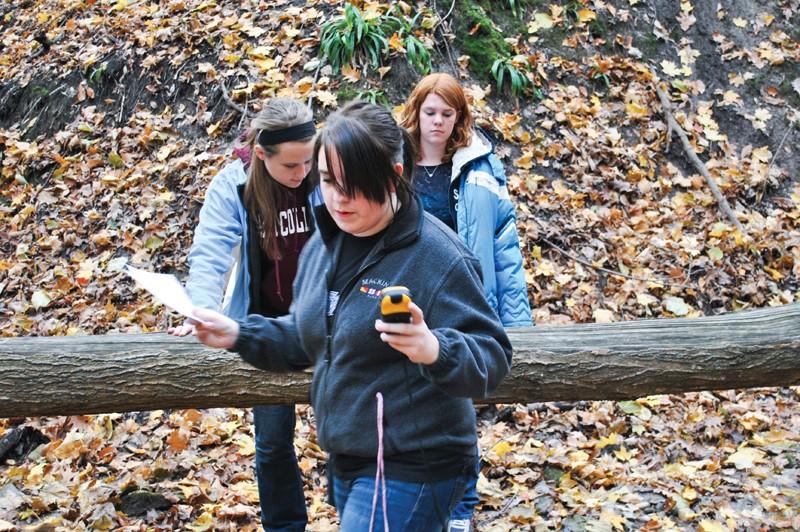Despite unpredictable weather, students take to the woods for hands-on learning

GVL / Allison Young GVSU students exploring the ravines around campus.
Mar 1, 2012
For most students at Grand Valley State University, going to class means heading to the same room and sitting in the same seat dozens of times throughout the semester, an experience that is monotonous for many. Occasionally, as weather warms, professors take their classes to alternate places both indoors and out.
Allison Burke, a senior biology student, fondly remembers her class last summer on identifying plants.
“We hiked around the ravines, collected leaves and identified them,” she said. Burke’s class also traveled to nearby forest and bog areas off campus to check out other plant types.
“For our particular class, being out in the elements made the learning much more enjoyable,” Burke said. Being able to see, feel and smell the plants she was studying made a big difference compared to just reading about the plants, she said.
“Sometimes the weather gets in the way,” Burke said, adding that she still enjoyed the sense of adventure she felt during her class last summer. Senior movement science major Hanna Jones said she used to have an English class that used the same outdoor teaching methods.
“I liked it,” said Jones, whose class met in Robinson Field neat Mackinaw Hall. “I enjoyed the sun and the refreshing feeling of being outside… but seeing all the students was distracting.”
Professors, too, see a benefit in getting students out of the traditional classroom setting. Movement science professor John Kilbourne, for example, takes his Movement 101 classes to Robinson Field and the turf building so the students can play sports they learned about in class, such as an early form of baseball called “townball.”
Kilbourne said a side benefit to getting students moving around and in different locations than a classroom is that it allows them to be free from electronic devices that can take away from the learning. Kilbourne, a vocal advocate for bringing more movement to the realm of education, said educators have been aware of the link between physical activity and learning dating back to the 1700s, adding that Socrates would often lecture his pupils while walking. Holding classes outside and in other areas that are different from the typical classroom setting can alleviate some of the shortfalls of traditional sit-down classes, where students are not stimulated physically.
Kilbourne is also working on a fitness trail for the Allendale Campus, much like one that weaved through the ravines near the Calder Art Center many years ago. The trail, or par course, as he called it, would allow students to exercise outside at a series of stations featuring wooden equipment set on a trail through the trees. “I take my students outside as often as I can,” Kilbourne said. “I try to get them up and moving as much as I can.”






















